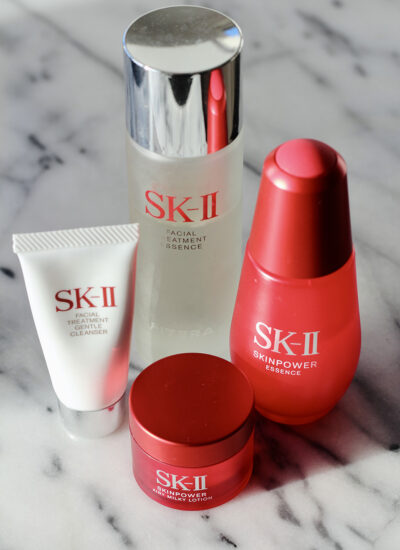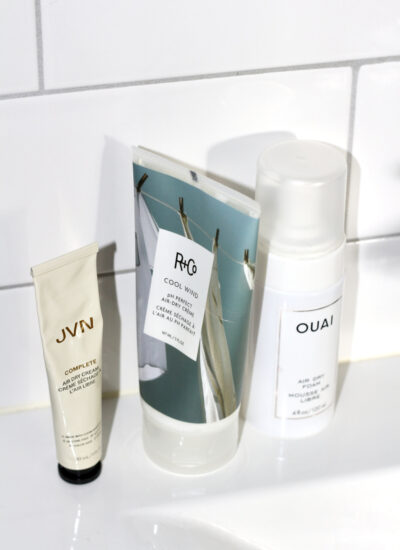
During the six years of growing out my hair, this last one has been the most educating of them all! I’ve done a lot of trial and error, trying on trends and skipping on the most obvious. While avoiding heat and trimming your own hair are some no-brainers, here are six lessons that made me finally have consistently healthy and shiny hair every single wash!
Shampoo & Conditioner Can Either Make or Break Your Hair
What you decide to use in the shower has a direct impact on the outcome of your hair when it dries and the results when styled. It usually only takes as little as one wash to notice a difference! See your shampoo and conditioner as your foundation, prepping the hair for what’s to come both styling-wise and in the upcoming days. I’ve literally sometimes blamed a styling product for bad results when it was the actual foundation that was at fault! With the right shampoo and conditioner, you should expect easier-managed and shinier hair, less breakage, and split ends.
This takes me to my second hair lesson…
Hair Cycle Your Washing Routine
There’s this old saying you should switch shampoo every third month. Not heard of it? Oh well… I believe the general consensus about the rule was to switch things up in order for your hair and scalp to not become too used to the products; decreasing their efficiency. While I never believed in it or followed this rule (still think it’s a bit of b*llsh*t), I now feel like there is something to it. Let me explain…
Just like you would typically switch your moisturizer depending on seasons and environment. Or when you use retinol and acids on certain days then focus more on hydration on the other. You should probably do the same for the hair if you have multiple hair concerns. I’ve jumped from one shampoo to the next, to then settle. Then, a few months in, feel like something’s missing again. Evoking a new cycle of trying to find “the one”.
It’s taken me a dozen rounds of these to realize why I wind up unsatisfied with the products I settle for. Although making my hair feel amazing at first, it’s not what my hair is in need of for months on end. Generally speaking, you need to take into consideration environmental change and watch what you do to your hair. For example, I have periods where I style a lot with hot tools to then mostly air dry. When I style with hot tools my hair will be more responsive to and in need of repairing products. While using the same products on mostly air-dried hair may lead to protein overload.
Alternate Products More Often
Personally, my hair has been able to maintain its best shape when I rotate between repairing and hydrating. I basically “hair cycle” my haircare products. Where every third wash I focus on deep repair and then smother it with hydration. Check out my post on hair cycling for an example schedule and products I use.
My main point here is that you should find a few favorite shampoos and conditioners with different benefits and rotate between them. Depending on your needs, of course. If you’re totally satisfied with sticking to just one washing routine, you should do it. This is just what has worked the best for my textured and breakage-prone hair. It was a hard pill to swallow. But I had to accept that continuously washing with hydrating products made my hair flat and my scalp oily. But on the other hand, constant washing with repairing products made my hair crisp and dry. Through hair cycling, I’ve found a way to balance my hair needs and always end up with great nourished shiny hair after every single wash.
A Cut Or A Trim Isn’t Always Necessary
I’m a big proponent of trimming your ends for healthy hair. And this is not me saying you should skip regularly cutting off split ends! But with the knowledge I just shared above, sometimes it’s just a crappy washing routine that’s at fault. And in some rare cases, it’s also not using the right styling products after your wash.
At the start of the year, I switched to a new of shampoo and conditioner that dried out my hair. Not aware of the first lesson, I was starting to believe this [length of hair] is as far as my hair will go. Thinking I need to soon do a big chop as my hair was looking fried. Then I finally switched washes again and it’s amazing how fast my hair recovered! The right foundation made my hair go from a frizzy dry mess to a shiny soft mane in just one wash!
And as a side hair lesson, I learned that as your hair gets longer it’s important to wash it with hydrating products! Which I was avoiding because of the fear of flat greasy hair.

Use Split-End Serums On Freshly Cut Hair
Something that has become quite evident is the misuse of split-end menders. Or maybe it’s just me? I’ve talked before about how and why I’m pro silicone in hair products. And many split-end mending products are silicone-based. I’m actually quite late in the game and wish I started using a split-end serum much sooner. As your hair gets longer and older, and with the occasional use of hot tools, ends become weak and before you know you’re losing more hair in the ends faster than your hair can grow.
Split-end serums are great at strengthening the bonds and preventing ends to shed. Helping you to keep length and density to the ends. However, like myself, it’s easy to start using them when the damage has already been done. Which is not the most optimal use and can end in dispointment. Split-end serums are best used after you’ve trimmed or gotten your hair cut to protect and extend the health of your ends. They can definitely be used on already damaged hair to minimize the look. But overall I found the best use is on healthy ends to prevent and extend the time for split ends from forming.
I’ve been using Amika The Closer and found I had to take a lot less for my ends to feel healthy. I also saw a greater reduction in how quickly split-ends would form after a trim by adding this to my routine. Also, if you want shiny hair, this serum, applied to damp hair before drying, will you give you the glossies locks!
Always Do A Pre-Wash Oil Treatment For Healthier Ends
Another must-do for healthy ends! So simple and obvious but so overlooked. I’m embarrassed that I only now just started oiling my ends, leaving it on for at least an hour, before washing. It usually would be an occasional treatment of some sort. But now I do it before every single wash. Sidenote: If your hair is short and healthy, oiling before every wash is not necessary. These lessons are more from the perspective of having long hair and how to care for it.
I kept suffering from dry fragile ends that only seemed to get worse until I trimmed a large chunk of it. Oiling before washing has made a tremendous difference in keeping my ends looking healthy and hydrated, and giving me shiny hair! This technique of applying oil on dry hair before washing helps to water-proof hair from soaking up too much water which leads to dehydration in high porosity areas (meaning: your ends). Love this blog for more sciency info!
My favorite pre-washing oils are pure coconut and baobab oil. Both of these are able to penetrate the hair strands and protect fragile cuticles. Coconut may turn hair crispy for some, I recommend mixing it with another carrier oil or using less of it.
Bonding Treatments and Repair Products Ain’t Just For Color-Treated Hair
I avoided anything repairing for years because I generalized they were only for color-treated bleached hair. But if you use hot tools, a blow drier, or even brush your hair, you are qualified to use a bonding treatment!
As repeated many times before, longer hair = older hair = more damage-prone hair. And repairing products has been great at strengthening my hair strands making them more tolerant to heat and brushing. They’ve also helped my hair recover from that occasional heat styling for a special event. But overall, like split-end serums, a bonding treatment has helped me shed less at the ends helping my hair keep getting longer.
To name a few of my favorites: Olaplex No3 and Bumble & Bumble Bond-Building Treatment will help strengthen and recover, giving you the shiny hair of your dreams!







